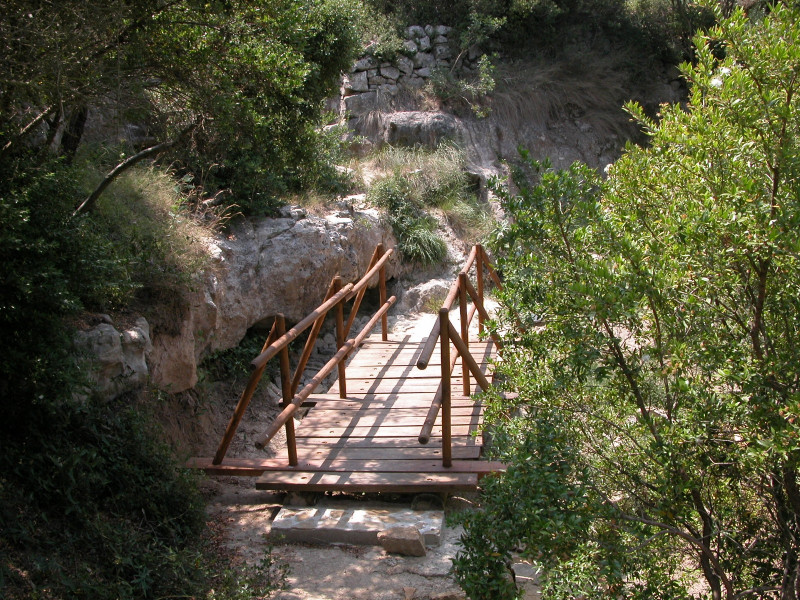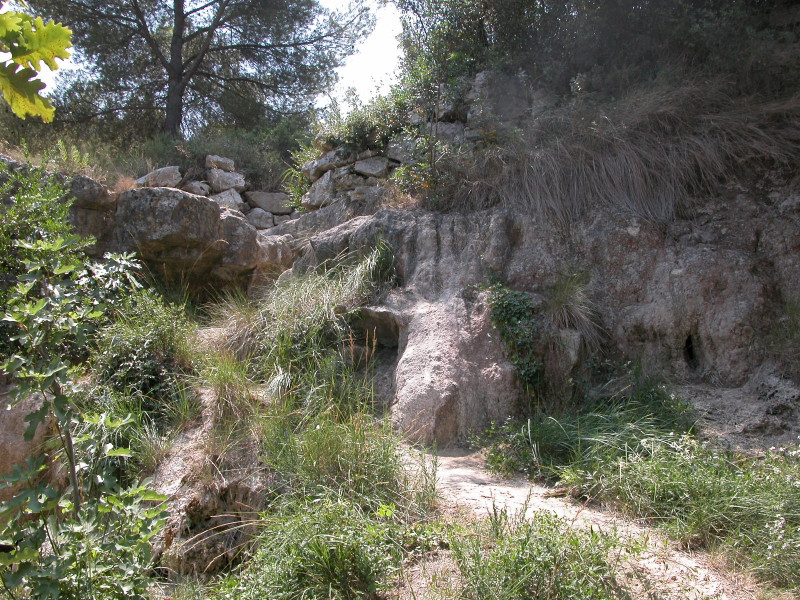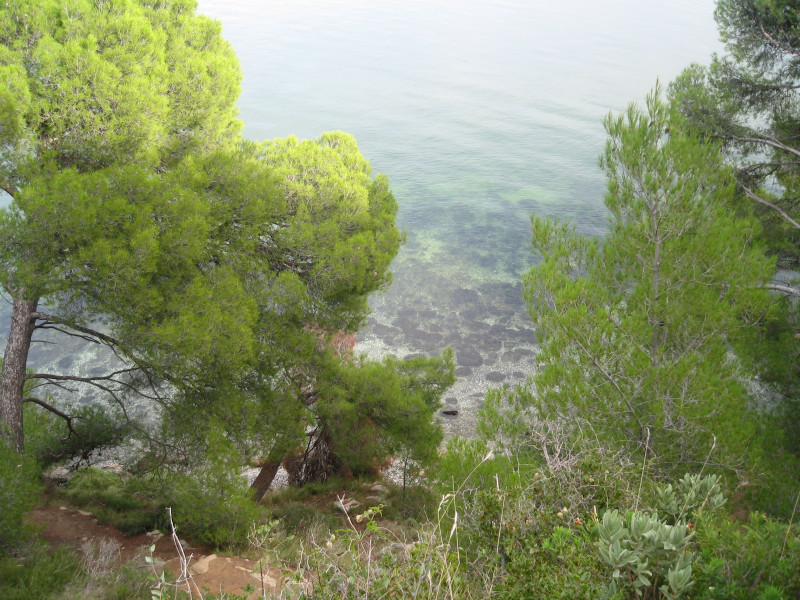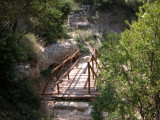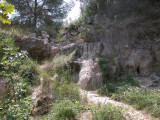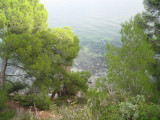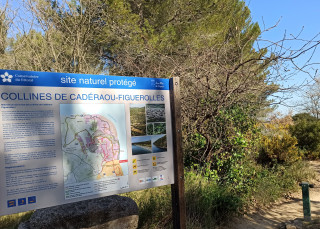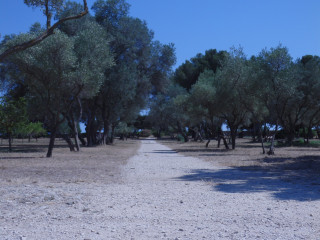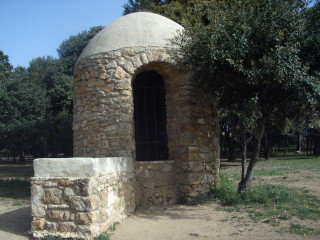The trail of restanques
Sport Pedestrian sports Course Themed pathPresentation
The large park of Figuerolles is a territory of 130 hectares, where past agricultural activities have left many traces in terms of rural heritage and crops (olive trees, fruit trees ...).
This territory has since been reclaimed by scrubland, pine forests and oak groves. Regular clearing of the park has encouraged the regrowth of deciduous trees and the discovery of the remains of 19th century farms.
On the edge of the Etang de Berre, the spray allowed the installation of a typical flora resistant to salt. The presence of an aquifer at the altimetric coast + 35m, on the Figuerolles plateau has led to the appearance of trees and plants developing in a humid environment (white poplar, ash, elm, elderberry, fig tree, etc.) .
Nationally protected plant species abound throughout the site. In the large municipal park of Figuerolles, there is a significant amount of trees of great aesthetic value (umbrella pines, holm oaks, white oaks, olive trees, cypresses, fig trees ...)
The large municipal park of Figuerolles offers the public the discovery and recognition of some fifty of these plants belonging to different Mediterranean environments. They are spread over 27 stations on a 2-kilometer loop trail, set in a remarkable natural environment.
• The forest is always green there
The holm oak is very widespread there, associated with the kermes oak. White or pubescent oak is also present with country elm, black elder, common ash and flowering ash.
The forest is mostly mixed, made up of deciduous and coniferous trees: Aleppo pine and umbrella pine.
The shrubs present in this forest are the lentiscus pistachio, the narrow-leaved worm, the common myrtle, the hawthorn, the Judean tree.
• Scrubland
It is characterized by a shrubby vegetation, composed of a large number of aromatic species.
In addition to cistus (white, sage leaf), the most typical plants of the garrigue are thyme, rosemary, spurge, rue, kermes oak and cade juniper.
The scrubland is home to many species of plants that contribute to its flowering in spring: Montpellier aphyllante, marum helianthemum, immortal stoechas, doubtful stéhéline, globular shrub ...
• The dry meadow
A rocky and lean prairie is due to the loss of vegetation cover and soil erosion, especially after fires or grazing by livestock.
There are many grasses (branched brachypod, wild oats, oval egelope ...), papillionaceae (thornless bugrane, alfalfa, bituminous clover, coronilla, Spanish broom, gorse from Provence ...) and compounds ( thistle, thistle-Town Hall ..)
• Land formerly cultivated
On large areas or on narrow terraces on the hillside, the olive tree is the most widely cultivated tree around the Mediterranean.
The vine was also planted in Figuerolles, associated with fruit trees such as fig, almond, and quince.
• Salty areas
The presence of salt in the spray from the Etang de Berre, causes the development of a compact, homogeneous vegetation characterized by a low number of species: tamarisk, obione, fire purslane, crithme maritime, la maritime knotweed, maritime chard, false crist inula.
• Wetlands
The presence of water in a valley will promote the growth of large deciduous trees, such as white poplar, ash, elm or black elderberry.
At their feet grow lianas and Mediterranean undergrowth shrubs: sarsaparilla, asparagus, madder traveler.
Moisture seeps in dry land allow Provence cane, rush, pampas grass to develop.
On the edge of the Etang de Berre, the spray allowed the installation of a typical flora resistant to salt. The presence of an aquifer at the altimetric coast + 35m, on the Figuerolles plateau has led to the appearance of trees and plants developing in a humid environment (white poplar, ash, elm, elderberry, fig tree, etc.) .
Nationally protected plant species abound throughout the site. In the large municipal park of Figuerolles, there is a significant amount of trees of great aesthetic value (umbrella pines, holm oaks, white oaks, olive trees, cypresses, fig trees ...)
The large municipal park of Figuerolles offers the public the discovery and recognition of some fifty of these plants belonging to different Mediterranean environments. They are spread over 27 stations on a 2-kilometer loop trail, set in a remarkable natural environment.
• The forest is always green there
The holm oak is very widespread there, associated with the kermes oak. White or pubescent oak is also present with country elm, black elder, common ash and flowering ash.
The forest is mostly mixed, made up of deciduous and coniferous trees: Aleppo pine and umbrella pine.
The shrubs present in this forest are the lentiscus pistachio, the narrow-leaved worm, the common myrtle, the hawthorn, the Judean tree.
• Scrubland
It is characterized by a shrubby vegetation, composed of a large number of aromatic species.
In addition to cistus (white, sage leaf), the most typical plants of the garrigue are thyme, rosemary, spurge, rue, kermes oak and cade juniper.
The scrubland is home to many species of plants that contribute to its flowering in spring: Montpellier aphyllante, marum helianthemum, immortal stoechas, doubtful stéhéline, globular shrub ...
• The dry meadow
A rocky and lean prairie is due to the loss of vegetation cover and soil erosion, especially after fires or grazing by livestock.
There are many grasses (branched brachypod, wild oats, oval egelope ...), papillionaceae (thornless bugrane, alfalfa, bituminous clover, coronilla, Spanish broom, gorse from Provence ...) and compounds ( thistle, thistle-Town Hall ..)
• Land formerly cultivated
On large areas or on narrow terraces on the hillside, the olive tree is the most widely cultivated tree around the Mediterranean.
The vine was also planted in Figuerolles, associated with fruit trees such as fig, almond, and quince.
• Salty areas
The presence of salt in the spray from the Etang de Berre, causes the development of a compact, homogeneous vegetation characterized by a low number of species: tamarisk, obione, fire purslane, crithme maritime, la maritime knotweed, maritime chard, false crist inula.
• Wetlands
The presence of water in a valley will promote the growth of large deciduous trees, such as white poplar, ash, elm or black elderberry.
At their feet grow lianas and Mediterranean undergrowth shrubs: sarsaparilla, asparagus, madder traveler.
Moisture seeps in dry land allow Provence cane, rush, pampas grass to develop.
Practical information
- Route :
- Daily duration (minutes) : 120
- Route : Aller / Itinerance
- Price :
- Free
- Parking :
- Free car park
- Visits :
- you can visit it
- Average group visit length (minutes) : 240
- Services :
- Pets welcome
- Natures field :
- Clay
Facilities, services, amenities
- Leisure facilities :
- Picnic area
- Play area
- Environments :
- Close to GR footpath
- Individual tour services :
- Unguided individual tours available permanently
- Restaurants :
- Restaurant
- Bathroom/toilets :
- Public WC
Tarifs
Free of charge.
Contact
The trail of restanques
Avenue du grand parc
13500
Martigues
Phone : +33 4 42 49 11 42
FICHE_INFO_SIMPLE_LIBELLE_DESTINATION
Le sentier des restanques
Avenue du grand parc
13500
Martigues
GPS coordinates
Latitude : 43.433236
Longitude : 5.048715
We also suggest ...
On site
Pedestrian sports Hiking itinerary
Martigues
(Location)
Nature is often very beautiful here and the farm animals can be seen very closely. What magic to see the gaze of children resting, sometimes for the first time, on curious, ...
-
Route :
- Distance (km) : 6
- Daily duration (minutes) : 150
Park and garden
The Mediterranean gardens of the Parc de Figuerolles are located on
the location of the former estate of the Sunhary Deverville family,
acquired by ...
-
themes :
- Garden
- Botanical garden
The visit takes place on the Figuerolles plateau from the main entrance of the Park to the ruin of the Restanques overlooking the pond of Berre.



